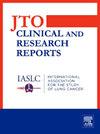免疫治疗时代肺腺癌肠分化的生存结局
IF 3.5
Q2 ONCOLOGY
引用次数: 0
摘要
肺腺癌(LUAD)伴肠分化(lay)是一种罕见的异质性非小细胞肺癌,具有侵袭性粘液、肠和胶质特征。在化疗时代,与其他luad相比,lay的预后较差。利用国家癌症数据库,我们评估了lay在免疫治疗时代的生存结果。方法查询国家癌症数据库2016 - 2019年诊断的IV期腺癌病例。lay被定义为浸润性粘液腺癌、胶质腺癌或肠腺癌。采用log-rank检验对生存分布进行未校正比较,并采用Cox多变量回归进行校正。结果共发现40516例患者,其中855例为lay, 39661例为其他LUAD。其中593例为胶体型,253例为黏液型,9例为肠型。与其他LUAD亚型相比,LAID患者的死亡风险更高,风险比(HR)为1.31(95%可信区间:1.21-1.43),中位生存期分别为9.19个月和11.81个月。这在所有治疗亚组中相对一致(HR = 1.40:单独免疫治疗,HR = 1.29:化学免疫治疗;HR = 1.25:单独化疗)。接受化学免疫治疗的lay患者的中位总生存期为11.16个月,单独接受免疫治疗的中位总生存期为9.19个月,单独接受化疗的中位总生存期为7.09个月。结论在免疫治疗时代,与其他luad相比,lay仍与较差的生存率相关。然而,在这个罕见的亚组中,与单独化疗相比,暴露于免疫治疗可能与生存率的提高有关。本文章由计算机程序翻译,如有差异,请以英文原文为准。
Survival Outcomes of Lung Adenocarcinoma With Intestinal Differentiation in the Era of Immunotherapy
Introduction
Lung adenocarcinoma (LUAD) with intestinal differentiation (LAID) comprises a rare and heterogeneous NSCLC of invasive mucinous, enteric, and colloid characteristics. In the era of chemotherapy, LAID was associated with a poorer prognosis compared with other LUADs. Leveraging the National Cancer Database, we assessed survival outcomes of LAID in the era of immunotherapy.
Methods
The National Cancer Database was queried for stage IV adenocarcinoma cases diagnosed from 2016 to 2019. LAID was defined as invasive mucinous adenocarcinoma, colloid adenocarcinoma, or enteric adenocarcinoma. An unadjusted comparison of survival distributions was performed using a log-rank test and adjusted by Cox multivariable regression.
Results
A total of 40,516 patients were identified, of whom 855 had LAID and 39,661 had other LUAD. Among the cases of LAID, 593 were classified as colloid, 253 as mucinous, and nine as enteric. Patients with LAID had a higher risk of death compared with other LUAD subtypes, with a hazard ratio (HR) of 1.31 (95% confidence interval: 1.21–1.43) and a median survival of 9.19 months and 11.81 months, respectively. This was relatively consistent across all treatment subgroups (HR = 1.40: immunotherapy alone, HR = 1.29: chemoimmunotherapy; HR = 1.25: chemotherapy alone). Patients with LAID treated with chemoimmunotherapy had a median overall survival of 11.16 months, 9.19 months when treated with immunotherapy alone, and 7.09 months when treated with chemotherapy alone.
Conclusions
Compared with other LUADs, LAID remains associated with poorer survival in the era of immunotherapy. Nevertheless, exposure to immunotherapy may be associated with improved survival compared with chemotherapy alone in this rare subgroup.
求助全文
通过发布文献求助,成功后即可免费获取论文全文。
去求助
来源期刊

JTO Clinical and Research Reports
Medicine-Oncology
CiteScore
4.20
自引率
0.00%
发文量
145
审稿时长
19 weeks
 求助内容:
求助内容: 应助结果提醒方式:
应助结果提醒方式:


